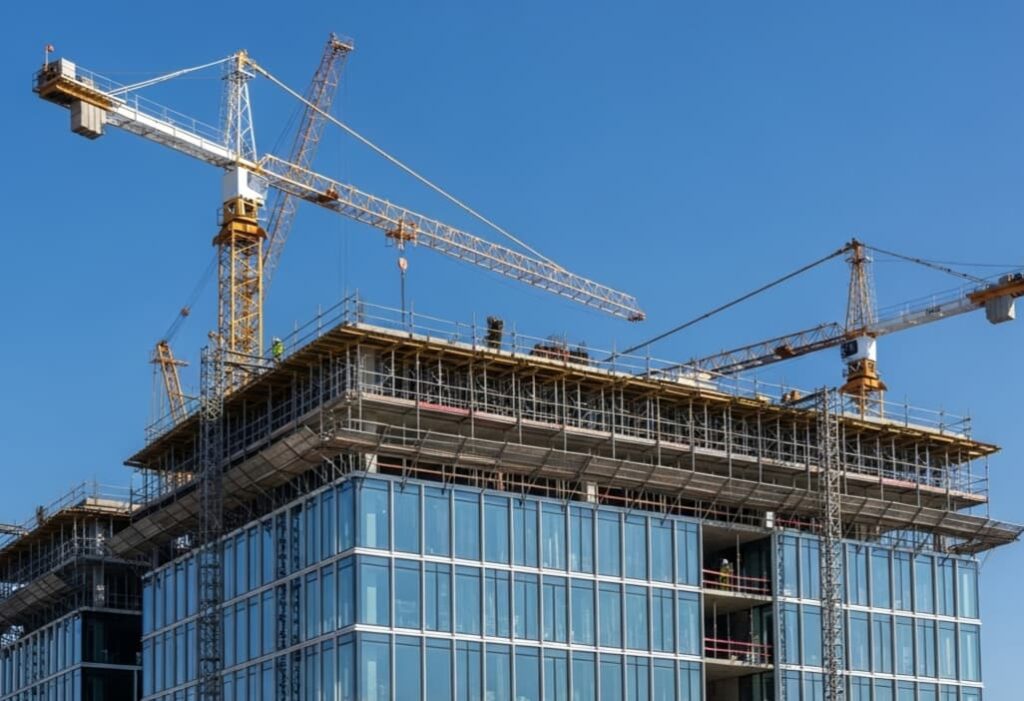A commercial construction loan is a specialized financing solution that provides the funds necessary to build or renovate a commercial property. Businesses, investors, and developers use these loans to cover costs associated with construction, including land acquisition, materials, labor, permits, and contractor fees. For example, a small business planning to build a new office space can secure a construction loan to cover initial costs without tying up its existing capital. Unlike traditional commercial mortgages, construction loans are short-term and finance projects still under construction. These loans allow businesses to fund construction efficiently, manage cash flow, and complete projects without upfront capital.
How Commercial Construction Loans Work
Commercial construction loans fund projects from start to finish, releasing money in stages called draw schedules, based on milestones like foundation or roof completion. This approach keeps work on schedule and reduces lender risk. Unlike standard commercial mortgages, these loans are temporary, usually 12 to 36 months, and convert into permanent financing once the project is complete, keeping projects financially manageable.
For example, a small developer building a multi-tenant office can receive 30 percent of funds for site prep, 40 percent for structural work, and the rest for finishing. After construction, the loan becomes a permanent mortgage, stabilizing long-term financing.
Loan terms vary depending on the property type, loan structure, and lender requirements. For example, a loan for a multi-family residential building may require detailed cash flow projections. In contrast, a loan for a single commercial office might focus more on land value and construction plans. Lenders also set conditions based on their policies, borrower experience, and project risk.
Types of Commercial Construction Loans
Ground-Up Construction Loans: These loans fund the construction of a new building on undeveloped land. They cover land acquisition, permits, materials, and labor costs. Before approving these loans, lenders evaluate project plans, budgets, and contractor experience. Ground-up loans typically require a detailed construction timeline, and lenders release funds in stages when borrowers meet milestones.
Construction-to-Permanent Loans: This type combines construction financing with long-term mortgage financing. The loan covers construction costs initially, and then the lender automatically converts it to a permanent mortgage once the borrower completes the project. This process eliminates the need for separate loan applications and reduces closing costs. Borrowers gain predictable financing and a streamlined process.
Hard Money Commercial Construction Loans: Hard money lenders provide short-term, asset-based financing solutions. Borrowers often use them when they do not meet traditional lending requirements, such as strong credit scores or conventional project types. These loans carry higher interest rates, but lenders approve them faster and provide quick funds for unique or time-sensitive projects.
Multi-Family Construction Loans: These loans finance multi-unit residential buildings and account for construction costs and potential rental income. Lenders review projected cash flow, occupancy rates, and the borrower’s experience managing residential properties. Under this loan type, borrowers can access both construction and permanent financing options.
Requirements for Getting Approved
Credit and Financial History: Lenders review both personal and business credit. A developer with strong credit and steady cash flow more easily secures approval. Update your financial statements before applying to strengthen your case.
Collateral and Down Payment: Lenders secure these loans with the property and expect a down payment of 20% to 30%. A borrower funding a $2 million project contributes $400,000 to $600,000 upfront. Preparing funds early prevents delays.
Business Experience and Track Record: Lenders trust applicants who complete projects on time and understand local regulations. Showing past work and relevant experience increases approval chances.
Project Documentation: Lenders expect detailed plans, budgets, and permits. Submitting accurate architectural drawings and realistic cost estimates proves the project is feasible.
Additional Considerations: Lenders weigh market demand and property location. A multi-family project in a growing city attracts more interest than one in a declining area.
Meeting these requirements reduces risk for both borrower and lender and supports a successful project outcome.
Commercial Construction Loan Process
Getting a commercial construction loan includes several stages that protect both borrower and lender. Each step confirms that the project is financially sound and achievable.
Application and Initial Discussion: The borrower submits an application and shares project details with the lender, such as property type, estimated costs, and timeline. At this stage, borrowers speed up the review by keeping documents organized.
Underwriting and Credit Review: To measure risk, the lender reviews financial statements, credit history, and project background. Borrowers answer questions quickly and provide clear records to avoid delays. This stage usually takes a few weeks.
Appraisal and Evaluation: An independent appraiser estimates the property’s value after completion. If the future value supports the loan request, the lender approves the project to move forward. Borrowers supply accurate project plans to support the appraisal.
Loan Approval and Closing: Closing finalizes the loan. The borrower provides a down payment, pays closing costs, and signs the agreement. The lender sets loan terms such as interest rate, repayment schedule, and draw schedule.
Disbursement and Draw Schedule: The lender follows a draw schedule to release funds in stages. For example, the first payment may cover land preparation, and later payments cover framing and finishing. Inspectors check progress before each release. Borrowers coordinate with contractors to keep work on track.
Conversion to Permanent Financing: In construction-to-permanent loans, the lender automatically converts the financing into a long-term mortgage once the borrower completes construction and meets occupancy rules. This shift saves the borrower from starting a new loan application.
Commercial Construction Loan Rates and Terms
Commercial construction loan rates in 2025 typically range from 6.8% to 13.8%, depending on the lender, borrower profile, and project risk. Borrowers with strong credit and low-risk projects usually secure rates on the lower end, while higher-risk projects face higher rates.
Loan terms are usually short, often 12 to 36 months, with repayment tied to construction progress. Borrowers generally make payments when lenders release funds through draw schedules.
Once construction is complete, many borrowers transition into permanent financing at lower long-term rates, often starting near 5% for stable commercial mortgages. This shift reduces monthly payments and stabilizes cash flow. Compare multiple lenders before applying, as rates and fees can vary significantly.
Best Commercial Construction Loan Lenders in 2025
Several major banks and lenders dominate the commercial construction loan market. Their offerings differ in scale, flexibility, and borrower fit, so choosing the right one depends on project type and priorities.
- Wells Fargo is one of the largest providers, with billions in active construction financing. They use structured draw schedules, where funds are released step by step as construction progresses. This method is suitable for nationwide developers handling large projects.
- JPMorgan Chase: Known for construction-to-permanent loans, which start as short-term construction financing and automatically convert to long-term mortgages. Best for large-scale borrowers seeking predictable financing and fewer loan applications.
- Bank of America: Popular for mid to large-scale projects, offering tailored financing with customized loan terms based on project needs. Ideal for borrowers wanting flexibility and nationwide access.
- U.S. Bank provides construction loans in all states and has a reputation for faster, streamlined approvals. It is a strong fit for borrowers who prioritize speed and efficiency in funding.
- PNC Bank: Competitive in selected states, offering attractive commercial real estate financing programs. It works well for regional borrowers, focusing on state-specific projects.
Borrowers should note that while big banks offer scale and stability, specialized lenders may better serve niche projects or urgent financing needs.
What Helps You Secure a Loan
Preparation is critical when applying for a commercial construction loan. Following these steps improves approval chances and smooths the overall process.
- Strengthen your credit profile and provide complete financial records. Lenders view strong credit as proof of reliability.
- Present a detailed business plan with accurate cost estimates and revenue projections. A clear plan shows lenders you can manage costs realistically.
- Choose experienced contractors and gather all required permits before applying. Selecting an established contractor signals reliability to the lender.
- Compare multiple lenders to evaluate interest rates, terms, and flexibility. Borrowers who explore options often secure better deals.
- Avoid underestimating costs, as lenders prefer conservative and realistic budgets. If costs are underestimated, lenders may reduce or even deny funding.
- Prepare documents early and respond quickly during the process. This saves time and helps underwriting move smoothly.
Conclusion
Commercial construction loans may seem complex, but they are essential for turning big projects into reality. Borrowers who understand loan rates, identify the right lenders, and prepare complete documentation increase their chances of approval. Planning, comparing financing options, and strong financial records help secure favorable terms. Choosing the right loan funds for construction supports the property’s long-term economic stability.
Common Questions from Borrowers
Which bank is best for a commercial loan?
Large banks such as Wells Fargo, JPMorgan Chase, and Bank of America dominate the market. The right choice depends on project size, location, and borrower profile. For instance, national projects may suit Wells Fargo, while a borrower with a significant urban development might find Chase more flexible.
How much deposit do I need?
Most lenders require 20 to 30 percent equity before approving financing. For example, a borrower planning a $2 million project should expect to contribute $400,000–$600,000 upfront.
What type of loan is best for commercial property?
Construction-to-permanent loans are popular because they cover both the building phase and long-term financing. This means you avoid the hassle of applying for a new loan after construction.
Are hard money loans a safe option?
They can be helpful when fast approval is needed or a project does not meet traditional bank requirements. However, interest rates are much higher, so they work best for short-term or urgent projects rather than long-term investments.




